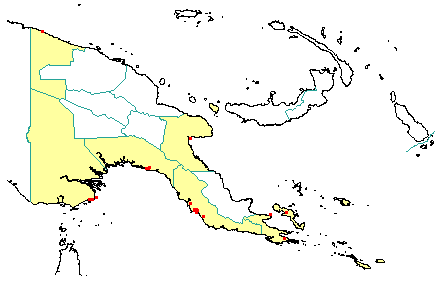
in PNGplants database
PNGTrees – Avicennia marina subsp. eucalyptifolia (Zipp.) J.Everett |
Barry Conn (NSW) & Kipiro Damas (LAE).
Copyright held by the authors, Royal Botanic Gardens and Domain Trust, and Papua New Guinea National Herbarium
Telopea Vol. 5: 629 (1994)
Other Literature: N.C. Duke, Australian Systematic Botany Vol. 4: 315-317 (1991) Fig. 8.
Field Characters: Large trees up to 30 m high or small trees. Bole cylindrical up to 46 cm diam; straight bole 10-12 m long; buttresses absent; spines absent; aerial roots absent; stilt roots absent. Bark brown, white (when dry), greenish grey, or green, slightly rough or smooth, often scaly or flaky with thin flakes; subrhytidome pale yellow or pale brown; bark thickness <25 mm thick; blaze consisting of one layer; faintly to non-aromatic; outer blaze white or pale yellow straw-coloured, markings absent, smooth; inner blaze pale yellow straw-coloured or white, markings absent, smooth; exudate absent. Terminal buds not enclosed by leaves; complex hairs absent; stinging hairs absent; mature twig without hairs.
Leaves: Spaced along branches <internodes readily visible>. Leaves opposite, simple; petiole present 7-11(-14) mm long, slightly winged amplexicaul at base, attached to base of leaf blade <not peltate>, swollen <at tip, or base, or both> at base; lamina broadest below middle, 5.5-7.5 (-9.3) cm long, 1.0-2.5 (-3.0) cm wide; lamina symmetric, margin entire, not dissected or lobed, apex long-tapering or slightly acuminate, venation pinnate <secondary veins arising from the midrib along its length>, secondary veins open <spaced far apart to easily see tertiary veins>, not prominent, but visible, intramarginal veins absent; lower surface grey or green, upper surface greenish brown, dark green, or green, hairs present, sparse finely pubescent on lower surface; oil dots absent; domatia absent; stipules absent.
Flowers: Inflorescence terminal <at branch ends>. Flowers on a branched axis; flowers bisexual, not stalked, with many planes of symmetry <actinomorphic>, 5.0-7.0 mm long, small (< or =10 mm diam.) 5-6 mm diam.; perianth present, with distinct sepals and petals, orange; inner perianth 4 (-6), some or partly joined lobes 2-3 mm long; stamens 4 (-8), filaments present, free of each other, joined to perianth <epipetalous/episepalous> ovary superior <seated above petals and sepals; hypogenous>, carpels joined (when more than one) <syncarpous>, locules 1; styles solitary <including joined together>, 1.
Fruits: Fruits arranged on branched axis. Fruit 10-16 (-20) mm long, 9.0-15.0 (-19.0) mm diam., fruit green, greenish grey, or pale brown, not spiny, non-fleshy, simple, dehiscent, capsule. Seeds 1 (-2), not winged, as wide as long.
Distribution: Gulf, Central, Milne Bay, Morobe, Papuan Islands, West Sepik & Western.
 | Botanical records in PNGplants database |
Notes: The seedlings (radical) of this species are 5-13 mm long, mostly glabrous but with a short densely hairy collar with hairs straight or wavy.
Previously known as Avicennia marina var. eucalyptifolia but to be consistent with the change of other infra-specific taxa within A. marina to the rank of variety, this taxon is here referred to as a subspecies of this species (refer J. Everett (1994) Telopiea 5: 627-629. Previously placed in the Verbenaceae and more recently in its own family, the Avicenniaceae.